
Lake Tanganyika is an African Great Lake. It is the second-oldest freshwater lake in the world, the second-largest by volume, and the second-deepest, in all cases after Lake Baikal in Siberia. It is the world's longest freshwater lake. The lake is shared among four countries—Tanzania, the Democratic Republic of the Congo (DRC), Burundi, and Zambia, with Tanzania (46%) and DRC (40%) possessing the majority of the lake. It drains into the Congo River system and ultimately into the Atlantic Ocean.

Haliotis cracherodii, the black abalone, is a species of large edible sea snail, a marine gastropod mollusk in the family Haliotidae, the abalones.

The terms shell dwellers or shelldwellers, shell-breeding, or ostracophil are descriptive terms for cichlid fish that use the empty shells of aquatic snails as sites for breeding and shelter. The terms have no taxonomic basis, although most shell-dwelling cichlids are from Lake Tanganyikas lamprologine lineage. Many shell dwelling cichlids are popular with fishkeepings and are frequently kept in aquaria.

Neolamprologus brichardi is a species of cichlid endemic to the alkaline waters of Lake Tanganyika in East Africa. It is a popular aquarium fish kept in the fishkeeping hobby, where it is known under a variety of common names including Princess cichlid, Princess of Burundi, Lyretail cichlid, Fairy cichlid and Brichard's lamprologus. In addition, the species is also the subject of numerous studies on fish behaviour. It is closely related to N. pulcher from the southern half of Lake Tanganyika and some have recommended merging the two into a single species.

Lamprologus is a genus of fishes from the cichlid family. They are native to Lake Tanganyika and the Congo River Basin in Africa. The type species for this genus is Lamprologus congoensis, a species from the Congo River. The genus is under some revision and may eventually be restricted to these riverine types.
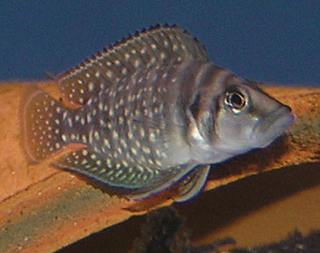
Altolamprologus is a small genus of pseudocrenilabrine cichlids endemic to Lake Tanganyika in eastern Africa. They inhabit areas of the lake with large amounts of rock, most frequently in water two to ten metres in depth. Two formally described species comprise this genus, with perhaps one dwarf A. compressiceps-like species being considered an undescribed species by some.
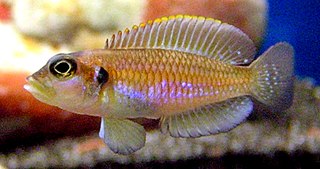
Lamprologus ocellatus is a species of shell dwelling cichlid endemic to Lake Tanganyika. It is a popular aquarium fish due to its small size, appearance, and intelligence.

Xenotilapia is a genus of cichlids species endemic to Lake Tanganyika in east Africa.

Lamprologus callipterus is a species of cichlid endemic to Lake Tanganyika where it very actively moves about in search of crustaceans and other invertebrates. Males of this species can reach a length of 12.4 centimetres (4.9 in) TL while the females only grow to 4.5 centimetres (1.8 in) TL. This fish can also be found in the aquarium trade, though it is considered to be poorly suited for captivity.
Lamprologus finalimus is a little-known species of cichlid endemic to Lake Tanganyika where it is currently known only from its type locality - Uvira, Democratic Republic of the Congo - on the northern tip of the lake. The only known specimen, the holotype, was 4.5 centimetres (1.8 in) in total length.
Lamprologus signatus is a species of cichlid endemic to Lake Tanganyika where it prefers deep waters over muddy substrates. This species is a shell dweller. This species can reach a length of 5.5 centimetres (2.2 in) TL. It can also be found in the aquarium trade.

The fourspine cichlid is a species of cichlid endemic to Lake Tanganyika where it lives in areas with sandy substrates. In addition to feeding on other fishes and insect larvae, this species is specialized to suck molluscs from their shells. This species can reach a length of 20 centimetres (7.9 in) TL. This species can also be found in the aquarium trade.
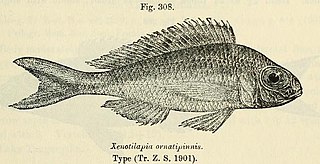
Xenotilapia ornatipinnis is a species of cichlid endemic to Lake Tanganyika where it can be found in schools in areas with sandy substrates. This species can reach a length of 12.5 centimetres (4.9 in) TL. It can also be found in the aquarium trade.

Polypterus ornatipinnis, the ornate bichir, is a bony fish found in Lake Tanganyika and the Congo River basin in Central and East Africa.

The hawksbill sea turtle is a critically endangered sea turtle belonging to the family Cheloniidae. It is the only extant species in the genus Eretmochelys. The species has a global distribution that is largely limited to tropical and subtropical marine and estuary ecosystems.

Lamprologini is a tribe of African cichlid fishes. It contains seven genera and nearly 100 species. Over half of the species in this tribe are in the large genus Neolamprologus. Most genera in the tribe are endemic to Lake Tanganyika, but one species of Neolamprologus is from the Malagarasi River in Tanzania, and several species of Lamprologus are from the Congo River Basin.
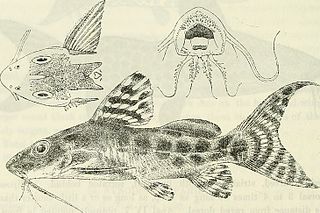
Synodontis ornatipinnis, known as the barfin synodontis, is a species of upside-down catfish that is native to the Congo Basin of the Democratic Republic of the Congo and Zambia. It was first described by British-Belgian zoologist George Albert Boulenger in 1899, from specimens collected in Mbandaka, on the Congo River in what is now the Democratic Republic of the Congo. The species name ornatipinnis means "ornate fins".
Lamprologus lethops is a species of cichlid fish from areas with fast current in the Congo River in Central Africa, where it is believed to live in depths as great as 160 m (520 ft) or 200 m (660 ft) below the surface. It reaches up to about 12.5 cm (5 in) in standard length, with females being somewhat smaller than males, is all whitish in color (non-pigmented), and essentially blind as adult, as their eyes are covered in a thick layer of skin. This is entirely unique among cichlids and an adaption to the perpetual darkness of its habitat, similar to the adaptions seen in cavefish. The eyes of juveniles are rudimentary and not covered by skin.
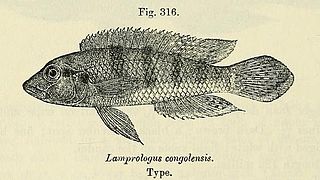
Lamprologus congoensis, the Congo lionhead cichlid is a species of riverine cichlid which is widespread in the Congo River, it is the type species of the genus Lamprologus.
Channa ornatipinnis is a freshwater species of snakehead, a fish of the family Channidae. It is found in tropical Asia. They can get up to 30.5 cm (12.0 in) long.















